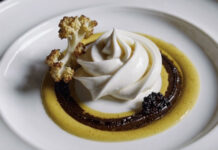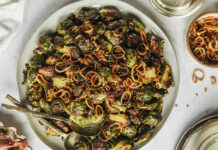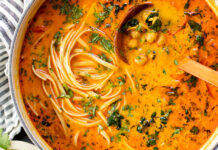
A single ingredient—when honored, deconstructed, and reimagined—can transcend expectation. Enter the grapefruit: bold, bitter, and bright. This dish, Grapefruit Crudo with Yuzu Caviar and Charred Shiso Oil, elevates the humble citrus into a symphony of flavour and texture, blending modernist techniques with a deep respect for natural ingredients.
Grapefruit, often relegated to breakfast bowls and cocktails, finds new expression here. Its sharp acidity and bittersweet notes are tempered by floral yuzu caviar, an ethereal burst of brightness created through spherification. A whisper of charred shiso oil adds umami and smoke, while crushed pink peppercorns leave a lingering warmth. Together, these elements engage the palate in a dialogue of sweetness, bitterness, tartness, and spice.
Serves: 2
Ingredients
Grapefruit Crudo:
- Fresh ruby grapefruit – 2 large (about 600 g total)
- Sea salt – 1 pinch
- Extra virgin olive oil – 15 g (1 tbsp)
- Microgreens – small handful for garnish
Yuzu Caviar (Spherification):
- Fresh yuzu juice (or substitute with a mix of lemon and lime) – 100 g
- Sodium alginate – 2 g
- Cold water – 200 g (for bath)
- Calcium chloride – 2 g
Charred Shiso Oil:
- Fresh shiso leaves – 10 leaves (about 10 g)
- Neutral oil (grapeseed or similar) – 50 g
- Salt – 1 pinch
Pink Peppercorn Dust:
- Pink peppercorns – 5 g (about 1 tsp)
Method
1. Crafting the Yuzu Caviar:
In a nod to modernist cuisine, we begin with spherification. Blend the yuzu juice and sodium alginate until fully dissolved, then allow it to rest for 30 minutes, removing air bubbles. Meanwhile, create a spherification bath by dissolving calcium chloride in 200 g of cold water. Using a dropper, gently release the yuzu mixture into the bath. The droplets will transform into delicate caviar-like spheres. After one minute, remove and rinse them under cold water. Set aside.
2. Infusing the Charred Shiso Oil:
Heat a dry pan until it smokes lightly, then sear the shiso leaves for 10 seconds on each side until slightly blackened. The leaves’ grassy brightness evolves into something richer and deeper. Blend the charred leaves with neutral oil and a pinch of salt, then strain through a fine sieve. The resulting oil is vibrant green, smoky, and herbaceous.
3. Preparing the Grapefruit Crudo:
Segment the grapefruit with precision: trim away the peel and pith, then carefully carve out the segments. Season them with a whisper of sea salt and a gentle drizzle of olive oil to heighten their natural sweetness.
4. Creating Pink Peppercorn Dust:
Toast pink peppercorns lightly in a pan to release their floral aroma, then grind them to a cloud of fine dust using a mortar and pestle. This subtle spice will finish the dish with a fragrant, peppery bite.
Plating with Intention
Plating is an art form, and this dish is a study in minimalism. Arrange the grapefruit segments on a chilled plate, allowing their natural color to shine. Dot the composition with delicate spheres of yuzu caviar, adding pops of texture and acidity. Gently drizzle the charred shiso oil around the plate, creating a pattern reminiscent of brushstrokes. Finally, dust the dish lightly with pink peppercorn powder and garnish with a few microgreens for a touch of freshness.
A Flavor Journey: The Tasting Experience
On the palate, the dish is a masterclass in contrast. The grapefruit’s bright acidity is softened by the floral burst of yuzu caviar. The charred shiso oil lends a savory smokiness, grounding the dish with an earthy undertone. Pink peppercorn, with its subtle spice and floral notes, lingers in the background, rounding out the experience.
Pairing Notes:
A dish of such elegance calls for a refined companion. A dry Riesling with bright acidity and minerality echoes the grapefruit’s citrus notes while taming its bitterness. Alternatively, a sparkling junmai sake with subtle umami undertones will harmonize beautifully with the charred shiso and yuzu.
This Grapefruit Crudo with Yuzu Caviar and Charred Shiso Oil is more than a dish—it is an experience. It is a conversation between flavor, texture, and technique. It is proof that avant-garde cuisine need not be cold or mechanical; rather, it can celebrate the purity of ingredients while pushing the boundaries of culinary artistry.
So, slice, spherify, and savor—because sometimes, the most exciting journeys are those guided by a single ingredient.











